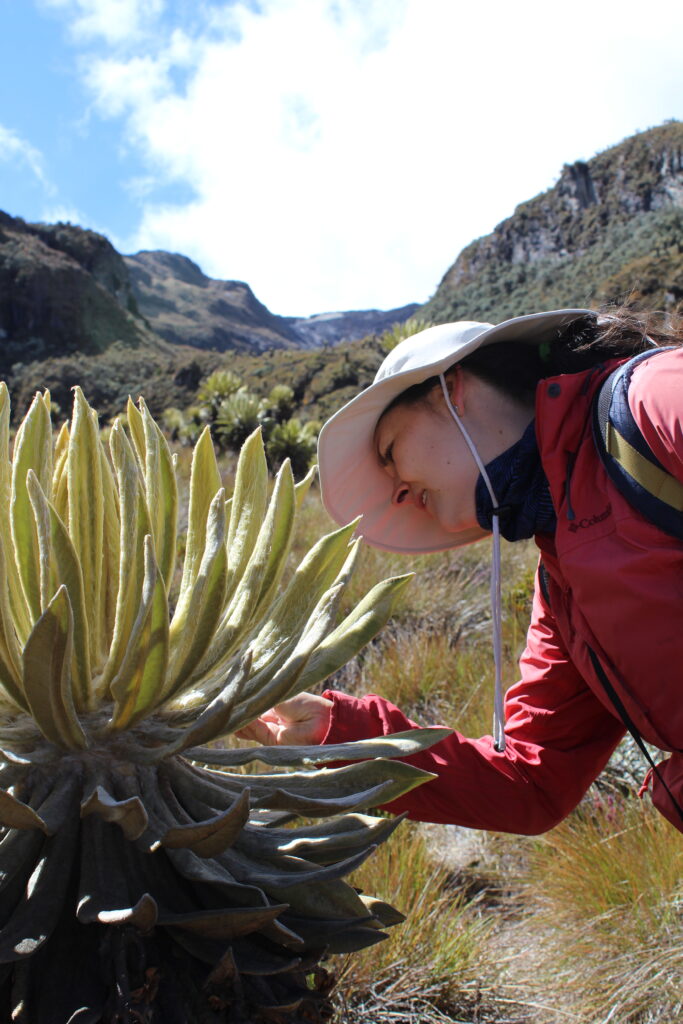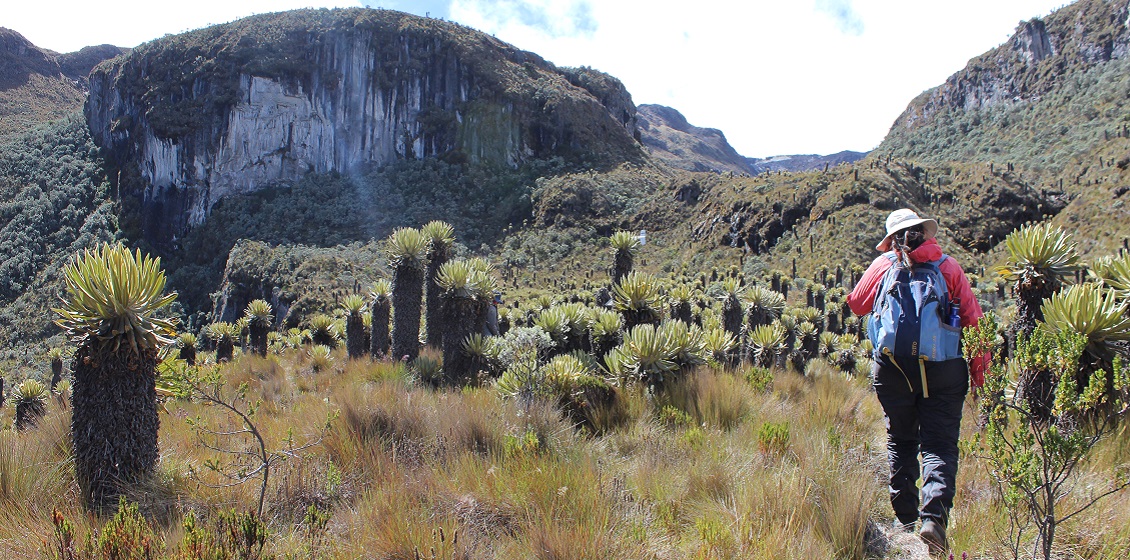Maria Elena Gutierrez-Lagoueyte, a young ecologist, from the Colombian city Medellin, studies in detail the plants of the páramos (the moorlands). She studies the plants in order to understand how the unique Andean ecosystem plays a central role in the water cycle, providing the drinking water for around 40 million people in South America. But we do not know how exactly those moorland plants function.
Over our heads flies a couple of impressive condors. From one side to another, they get closer still. A very special moment in the National Park Los Nevados, located west of the Colombian capital, Bogota. A smiling woman is walking through the tall vegetation. We’re surrounded by rocky and snowy mountains, the altitude around here is almost 4 kms. Ecologist Maria Elena Gutierrez-Lagoueyte (35) is on her way to make plant samples of some of the specific paramo plants. The most emblematic might be the Frailejones – Espeletia. Also, the so-called cushion plants are very typical for this ecosystem, which can be found in the páramos. Both plants serve as important water filters in the páramo.
Currently, this Colombian conservation biologist is working on a PhD on páramo resiliency at the National University in Bogota, at the same time as she works at a professor at the Department of Environmental Engineering, Antioquia School of Engineering in Medellin, Colombia.
In this National Park Los Nevados, the water resources connected here provides drinking water to 8 to 10 million people in Colombia. That is almost ¼ of the entire population of Colombia. And in general páramos are providing around 70% the drinking water in Colombia.
“We’re trying to understand the páramos, the moorlands. We know, that those ecosystems are essential to natural production of drinking water, but we don’t understand, exactly how”, Maria Elena Gutierrez-Lagoueyte says. Studying moorlands in Colombia makes a lot of sense: This Andean country is home to around half of the páramos in the world.
There is a small group of students joining Maria Elena Gutierrez-Lagoueyte and Daniel Ruiz Carrascal at this field trip. The passion is easy to notice. Everyone stays up late studying the plant samples that have been collected during the day. Everyone wants to go and see the glaciers. “Before it’s too late, before they disappear completely”.
The local inhabitant, Albeiro Mayorga Orjuela, is one example of that. Having walked the páramos for several decades, he transmits the stored experiences and oral knowledge: How people remember what things used to be like, how it used to rain, and which plants used to grow where. Important information for the scientists trying to get an understanding of climate change and its effects on the ecosystem.
“The conditions for studying climate change are difficult, because here in Colombia studies last normally for 2-3 years. But it doesn’t make sense to study climate change within such a short timeframe. We have been studying climate change here for 15 years, trying to create the necessary continuity but within different projects. The moorlands are warming as fast as the arctic and that must have consequences for our drinking water, we just don’t know exactly which.”
The páramos, as an ecosystem, communicates via clouds and precipitation with the lower located high Andean forest. In Colombia the páramos are protected for instance against agricultural and mining activities – but the high Andean forest is not. But manipulating the high forests with, for instance cultivating potatoes, also affects the páramos .
Maria Elena Gutierrez-Lagoueyte is, together with Daniel Ruíz Carrascal, a part of the Observatory for High Mountains, Poleka Kasue.
“We study the specific plants of the moorlands to be able to understand what happens when the temperatures are rising rapidly. Some plants can migrate up higher – but they can’t migrate as fast as animals. Other plants will die out because of the change and new plants will show up in the moorlands”. The researcher is trying to understand the resilience of these ecosystems; how fragile they are to the fast-changing climate.
“We don’t know what those temperature increasings will mean for the moorlands and in the end for our drinking water. OUR DRINKING WATER! That’s why it’s so important to study this,” Maria Elena Gutierrez-Lagoueyte explains.
The conditions for work and research are tough in the mountains.The researchers sleep in around 4 kilometers altitude. “It’s cold and hard for the body to stay here for longer time. Not everyone understands, but it’s difficult to work under those conditions,” says Maria Elena Gutierrez-Lagoueyte.
The same things are happening with the research in Colombia’s’ tropical glaciers, as with the general research about climate change: “The more we study the topic; [the more] we get to understand that those consequences are happening sooner that we first thought. At first, we thought that the glaciers would disappear in 2050. Then 2030. Now we believe some of them only have 2-5 years again – and some of the mountains already lost their glaciers. And this is happening right now”.
Maria Elena Gutierrez-Lagoueyte visits the national park every second month to check that the measure stations are working well, etc. To make sure that they are not losing important data. The team is measuring humidity in the soil every, then they installed two weather stations and 27 hob censors around the national park.
The páramos are unique ecosystems. And as they are well researched – everything is connected in the nature. If the tropical ecosystems get out of balance, it can get consequences for Europe as well. And then it’s about the so important resource and human right – water.
“We do those measurements to get a better idea of what the future will bring us. What the future will look like here in the páramos. To understand what’s happening with our drinking water too”.
Lise Josefsen Hermann is a Danish journalist based in Ecuador

Páramos and Moorlands
The moorlands are very characteristic open habitats in temperate highland areas. They are low nutrient, waterlogged soils with acidic. What characterizes the moorlands are the comprise of; heath-land, with shrubs like bilberry and ling heather, which a kinds of bushes with, typically, lilac wildflowers; acid grassland, with long wavy hair grass; and swampy landscapes, with sedges like cotton grass, which look just like small cotton balls on a string, dotted across a large field of swamp, and much more. Various grazing animals manage the organic process of growth in the moorlands. The importance of the moorlands, not only for the flora and wildlife living in the areas, but for humans as well, is crucial. The moorlands function as natural water reservoirs for all the rain falling in the areas, which they release into the rivers and streams running down the altitude areas, to benefit those living in proximity to the water. Source: https://www.worldatlas.com/articles/what-is-a-moorland.html
The flowers and plants in the moorlands in Colombia are absolutely crucial for the Colombian population, as it is estimated that approximately 70 per cent of the Colombian population gets their water supply form the Chingaza National Park, housing a large area of moorlands. However, due to the increasing extraction of the Colombian natural resources, such as oil, coal and gold, the Colombian moorlands are experiencing degradation of its unique ecosystems. This degradation not only influences the health of the unique ecosystem, but pollutes the drinking water, damaging the health of humans, animals and the environment. The mining of the natural resources in the country has increased from 1 million hectares to 8.5 million hectares (which covers approximately 8 per cent of the land area) over just a 10-year-period. Source:https://www.oecd.org/countries/colombia/Colombia%20Highlights%20english%20web.pdf
One of the plants commonly connected to the Colombian moorlands, is the Frailejones– know as the espeletia in English. This unique plant is a member of the sunflower family, but looks more similar to small palm trees, with distinct stubby trunks, and leaves which look like daisies on top. It is said that, when the Andes Mountains rose for more than 2.5 million years ago, the Frailejones evolved, and have lived on the mountains ever since. The defences of the Frailejones have evolved since then, and the white leafs protect the plants form the sun rays, whereas fallen dead leaves keep the trunks warm during the cold nights. Source: https://www.colombia.co/en/colombia-country/environment/lost-world-colombias-ancient-plants/



